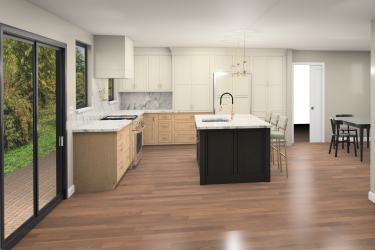
Image from Grand Design Magazines
A well-designed kitchen becomes the heart of a home, from cooking and hosting friends and family to crafting with the kids, it’s a place to create and share. As such, the kitchen is a great place to begin when shifting towards an eco-friendly home that promotes sustainability and ethical living. If you’re looking to redesign your kitchen, there are many more options than purchasing a new, expensive suite from a chain store. With a little imagination and some eco-savvy tips, you’ll be able to create a one-of-a-kind kitchen with all the benefits and half the cost. Here’s our best advice to help you get started.
Get Creative
Using reclaimed materials is the perfect way to keep your costs and environmental impact low when designing your new kitchen. Plus, there is a whimsical charm in using repurposed materials that you just don’t find with something run-of-the-mill. An old globe stand can become a kitchen roll holder, a chest of drawers revamped into a kitchen island, and kitchen cupboards can be easily restyled with some stunning vintage cabinet knobs.
Look in charity stores and online marketplaces to find reclaimed wood, furniture and rarities that could be repurposed and given a new lease of life. If you struggle to think creatively, there is a whole ocean of inspirational upcycling ideas at your fingertips on the internet, where people have used the most unusual odds and ends to create their own stunning, eco-friendly kitchens.
Opt for energy saving fixtures
Did you know that traditional bulbs only convert around 5% of electricity they use into light? Switching to LED lights will make your kitchen far more efficient and help save you money on your electricity bill too. The longevity of LED lights make them a great choice for incorporating under-cabinets to illuminate your worktops, as they rarely, if-ever, need to be changed.
If you are looking to change your taps, many retailers offer energy saving taps which are a great investment. You could also opt for aerated taps, which reduce the flow of water by up to 10 litres per minute, meaning big savings on your water bill.
It’s worth investing in energy saving appliances for your kitchen, too. If you buy new, look for the energy rating label to help you choose. Try to get the most efficient one you can within your budget. Don’t forget that you can also look for second-hand appliances – just make sure they are still in good condition.
Make gradual changes
Redesigning an entire space is stressful enough without worrying about having to replace every non-sustainable item that you own. If you have a set of plastic bowls, throwing them into the landfill and buying some nice wooden ones is not very economical, even if it may look that way to your guests. If you are looking to update your kitchen accessories and tableware, take them to a charity shop instead of the skip. Afterall, your junk may just be another person’s treasure.
You can also simply replace items as they break or deteriorate, and opt for more sustainable options when you do. Some things, like cling film and plastic tupperware, you need never buy again if you invest in some eco-friendly alternatives such as cloth or beeswax reusable food wraps and glass or bamboo containers.
Enjoy the process
However you decide to restyle your kitchen, enjoy the process and have fun creating a greener kitchen for you and your family to share. Doing a little upcycling is great therapy for the soul, and it feels great to create something unique while also saving money.





